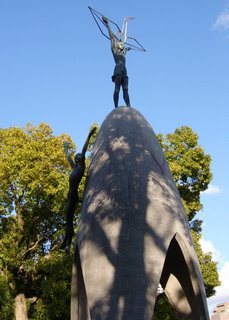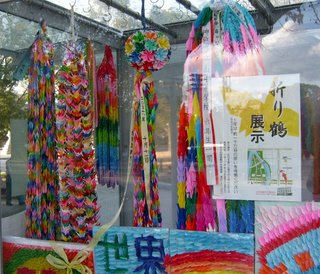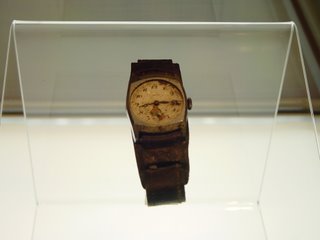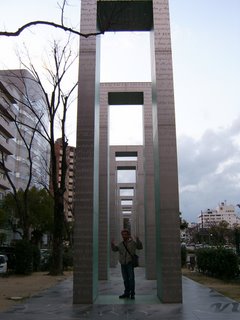Hiroshima - Peace Park and Museum
 Near the center of the Hiroshima Peace Park is a concrete, saddle-shaped monument that covers a Cenotaph holding the names of all of the people killed by the bomb. The Cenotaph carries the epitaph, "Repose ye in Peace, for the error shall not be repeated." Through the monument we could see the Peace Flame and the A-Bomb Dome.
Near the center of the Hiroshima Peace Park is a concrete, saddle-shaped monument that covers a Cenotaph holding the names of all of the people killed by the bomb. The Cenotaph carries the epitaph, "Repose ye in Peace, for the error shall not be repeated." Through the monument we could see the Peace Flame and the A-Bomb Dome.
 Sadako Sasaki was a Japanese girl who lived in Hiroshima and was two years old when the atomic bomb was dropped on August 6, 1945. At the moment of explosion she was at her home about 1 mile from ground zero. As she grew up, Sadako was a strong and athletic girl. At age eleven, while training for a big race, she became dizzy and fell to the ground. Sadako was diagnosed with leukemia, the "atom bomb disease".
Sadako Sasaki was a Japanese girl who lived in Hiroshima and was two years old when the atomic bomb was dropped on August 6, 1945. At the moment of explosion she was at her home about 1 mile from ground zero. As she grew up, Sadako was a strong and athletic girl. At age eleven, while training for a big race, she became dizzy and fell to the ground. Sadako was diagnosed with leukemia, the "atom bomb disease".
Sadako's best friend told her of an old Japanese legend that said that anyone who folds a thousand origami paper cranes would be granted a wish. Sadako hoped that the gods would grant her a wish to get well so that she could run again. However, it was not just for herself that she wished healing. It is said that what made the girl truly special in her effort was her additional wish to end all such suffering, to bring peace and healing to the victims of the world. She spent fourteen months in the hospital, and she folded over 1,300 paper cranes before dying at the age of twelve. She folded the cranes out of her medicine bottle wrappers and any other paper she could find in hopes of getting better.

 In 1958, this statue of Sadako holding a golden crane was unveiled in the Hiroshima Peace Memorial Park.
In 1958, this statue of Sadako holding a golden crane was unveiled in the Hiroshima Peace Memorial Park.
To this day, people (mostly children) from around the world fold cranes and send them to Hiroshima where they are placed near the statue. The millions of cranes are assembled into long strings or into collages making up pictures, often presenting an inspiring message of world peace. After display, the cranes are pulped and recycled into bookmarks, notebooks and other souvenirs which are sold at the park.


 The A-Bomb Dome is the skeletal ruins of the former Industrial Promotion Hall. It is the building closest to the hypocenter of the atomic bomb that remained at least partially standing. It was left how it was after the bomb in memory of the bombing.
The A-Bomb Dome is the skeletal ruins of the former Industrial Promotion Hall. It is the building closest to the hypocenter of the atomic bomb that remained at least partially standing. It was left how it was after the bomb in memory of the bombing.


 A statue of children in the Peace Park.
A statue of children in the Peace Park. This time piece stopped working with the impact of the bomb: 8:15am.
This time piece stopped working with the impact of the bomb: 8:15am. This is a tricycle and helmet that a 3-year old was using outside his house at the time of the bomb drop. The father buried the trike and helmet with his son (who was killed by the bomb); they were dug up 50 years later and donated to the museum.
This is a tricycle and helmet that a 3-year old was using outside his house at the time of the bomb drop. The father buried the trike and helmet with his son (who was killed by the bomb); they were dug up 50 years later and donated to the museum.These are Buddha statues that were destroyed by the bomb drop.


 These monuments are six gates covered with the word "peace" in forty-eight languages from around the world. They are lit up at night.
These monuments are six gates covered with the word "peace" in forty-eight languages from around the world. They are lit up at night.

1 Comments:
Wow! These pics above gave me chills. I'm so glad you shared these. It really puts a new perspective on life during war.
Post a Comment
<< Home